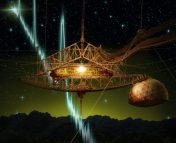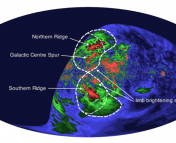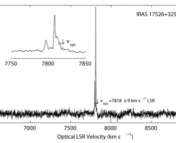- Title: Evidence of an Asteroid Encountering a Pulsar
- Authors: P. R. Brook, A. Karastergiou, S. Buchner, S. J. Roberts, M. J. Keith, S. Johnson, R. M. Shannon
- First Author’s Institution: University of Oxford
Pulsars- neutron stars formed during supernovae explosions- are often considered the “precision clocks” of radio astronomy. This is because of two fundamental properties observed from their radio pulses: the average emitted radio beam- known as the pulse profile– remains very stable over decades, and the pulsar has extreme rotational stability thanks to its fast rotation. All pulsars have a rotational frequency, ν, which is gradually decreasing due to a loss of energy, and its change with time, the spin-down rate, tells radio astronomers about the stability of the pulsar. Hundreds of pulsars have been observed to have glitches where the pulsar’s rotational frequency is seen to increase rapidly, and there have even been anti-glitch observations where the pulsar abruptly slowed down, which are thought to be caused by the magnetic fields of the pulsar.
But the interesting thing about astronomy is even in a field where things are as precise as pulsars, surprises will still crop up. And this is what happened during a 24-year observing campaign of PSR J0738-4042, when in September 2005 the spin-down rate abruptly changed and a new radio component was observed. In fact, no previously understood mechanism can explain these changes, and the observations led the paper’s authors to propose they witnessed an asteroid encountering the pulsar.

Figure 1- Top: The spin-down rate as a function of time during a ~1,700 day observation window. Bottom: The fraction of the pulse period over the same time- the period changing over time is associated with the drift feature.
The observations were relatively straightforward: PSR J0738-4042 is a bright radio pulsar and was the target of a monitoring campaign by the Hartebeesthoek Radio Astronomy Observatory (HartRAO) in South Africa for 24 years, and was observed by Parkes Observatory in Australia since 2007. HartRAO observed the pulsar every 1-14 days at either 1600 MHz or 2300 MHz for three consecutive 15-minute intervals, and Parkes observed monthly at 1369 MHz- a more sensitive telescope which increased the signal-to-noise ratio of the observations significantly. From these observations we can see that the spin-down rate is relatively stable for PSR J0738-4042 both before the 2005 event and about 1,000 days after. What’s interesting though is what happens in between, when the spin-down rate abruptly changed (see Figure 1) along with a rapid change in the pulse profile and a drifting radio component of the signal. What could cause such a significant change in the “precision clock” of a pulsar?
It turns out there are theoretical models that might explain the shifts, regarding what would happen when an asteroid or disk debris formed from supernova debris falls into a pulsar. Objects orbiting a pulsar are not a new idea- in fact, the first extrasolar planets discovered were orbiting a pulsar– and there are a myriad of reasons for why such debris could hit the pulsar, such as interactions with the pulsar’s magnetosphere or an eccentric orbit. Using these models and their observations of the changes of the pulse phase for the pulsar in 2005, the authors conclude that the change in spin-down rate could be caused by a change in the pulsar magnetosphere (which affected the pulsar’s breaking torque) due to a reduction of total plasma outflow above the polar caps. The amount of material that would cause the sort of changes observed would be an amount consistent with known asteroid masses within our solar system, such as 433 Eros. In short, it seems entirely possible that a rogue asteroid wandered too close to the pulsar and injected new material into the system, and this is what affected the changes in its pulses.
So what lies ahead for this pummeled pulsar? The authors predict that once the material injected by the asteroid is exhausted it will return to its original spin-down rate: a testable hypothesis which means PSR J0738-4042 will be monitored for many years to come. Further analysis of the data also suggests that some smaller amounts of debris might have encountered the pulsar in 1992 and 2010, leading to the possibility that a small planet in the system might periodically disrupt the debris disk and send material towards the pulsar. Such a planet must be less than ten times the mass of Earth or it would have been detected already. Further monitoring is required to test this hypothesis. So keep your eyes peeled: PSR J0738-4042 will likely remain an interesting target for radio astronomers eager for answers.





Trackbacks/Pingbacks